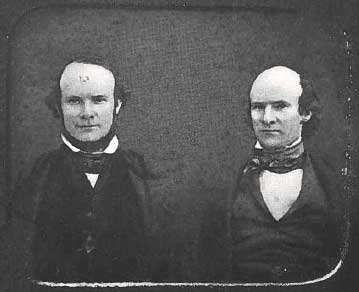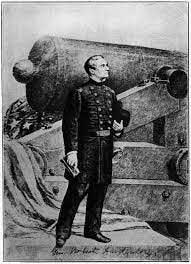Henry Brown began his career in 1793 as a military secretary during the Indian Wars in the Northwest Territory. After the Treaty of Greenville, which brought peace to the area, he remained as a trader in goods with the Native Americans and white settlers.
In 1804, Henry settled in Dayton, working as a merchant. During his lifetime, he promoted construction of a main roadway between Dayton and Cincinnati, and a canal to connect Dayton with markets in the east.
Henry married Catherine "Kitty" Patterson in 1811. Kitty was the daughter of Revolutionary War hero Colonel Robert Patterson and Elizabeth Lindsay Patterson; the Pattersons also settled in Dayton in 1804. Henry and Kitty had five children, three of whom lived to adulthood.
Henry and Kitty were married 12 years when he died from an unknown illness. Kitty married Andrew Irwin in 1826. They had one child, Andrew Barr Irwin. Andrew Irwin died in 1827.
In 1836, Kitty married Horatio G. Phillips. They had no children. Kitty spent much of her time engaged in charitable works and documenting the times in which she lived.

Henry and Kitty's eldest child, Robert Patterson Brown, became a Dayton lawyer and an associate judge. He married Sarah Galloway of Xenia, Ohio, in 1837. They had six children, three of whom died young. The family eventually moved to Kansas.
Henry Lindsay Brown, the third child, became a businessman and served on the Dayton School board for many years (1850 — 1873). He married Sarah Belle Browning of Dayton in 1837. The couple had nine children, eight of whom lived to adulthood. Henry L. owned an ironworks factory with his half-brother, Andrew Barr Irwin. They also owned Brown & Irwin Stove and Hardware in downtown Dayton.

Henry and Kitty's fourth child, Eliza Jane Brown, married Charles Anderson of Louisville, Kentucky, in 1835. Charles was a successful lawyer in Dayton and held several elected offices. He also commanded the 93rd Ohio Volunteer Infantry, mustered in Dayton, during the American Civil War. Charles was severely wounded at the Battle of Stones River (December 31, 1862 — January 2, 1863) and subsequently resigned.
In 1864, Charles became the seventh Lt. Governor of Ohio, then the 27th Governor on August 29, 1865, upon the death of Governor John Brough. Eliza held the position of First Lady of Ohio during that time. After Charles' 5-month term as governor, he resumed his law practice and moved his family to Kentucky. Eliza and Charles had six children, three of whom lived to adulthood.
Andrew and Kitty Irwin's son, Andrew Barr Irwin, married Jane Findlay Schenck of Suffolk, New York; they had four children. Andrew moved his family to Kuttawa County, Kentucky, where he became a judge.
Two of the Brown's grandsons served the Union during the American Civil War.
Ashley B. Brown, son of Henry L. and Sarah Belle Browning Brown, served as a lieutenant in the 12th Ohio Volunteer Infantry. Ashley was captured at the Battle of Scary Creek, West Virginia, on July 17, 1861, during the Civil War. His release from captivity and promotion to captain need further research.

Charles and Eliza Jane Brown Anderson's son, Allen, also served in the Civil War. He was educated in Dayton and graduated from the U.S. Military Academy at West Point in 1854. Allen initially served in New Mexico, but with the approaching Civil War, was promoted to colonel and commanded the 8th California Infantry Regiment. For meritorious service, he was brevetted (temporarily appointed) a brigadier general in March 1865.


Do you have photos, books or other information that you believe may be pertinent to this website?
Are you interested in contributing to our organization?
